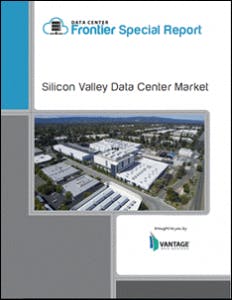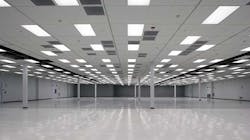Demand Remains Strong in Silicon Valley Data Center Market
We continue our series of stories on the leading geographic markets for data center space with a report on the Silicon Valley Data Center Market. Data Center Frontier is partnering with DatacenterHawk to provide in-depth market reports on each city we profile. This post focuses on demand trends in the Silicon Valley data center market.
Download the full report.
Silicon Valley is the second-largest market for commissioned data center space in the U.S., trailing only Northern Virginia. Requirements typically originate from companies already located in the region, often representing the primary West Coast footprint for larger web infrastructures. In many cases, companies see data center space in Silicon Valley as a strategic imperative that outweighs other factors, similar to the attraction of Manhattan or downtown Chicago.
In theory, companies objectively evaluating the market for expansion should be deterred by the area’s expensive real estate, power costs and risk of earthquakes. In reality, Silicon Valley has seen consistent activity from large data center users and colocation/cloud operators over the last five years. Companies seeking space in Silicon Valley have clearly found a comfort level with the cost environment and earthquake risk (which nonetheless is a common emphasis of data center providers in rival markets like Phoenix, Las Vegas, Reno and Sacramento).
Providers in Silicon Valley compete with several other markets. Hyperscale companies often weigh options in both Santa Clara and the Pacific Northwest, which offers cheaper land and power and a favorable climate for using outside air for cooling. It’s important to note that several cloud providers deploy capacity in both regions. Companies that are risk-sensitive may weigh options in Silicon Valley alongside providers in Phoenix or Las Vegas, which offer low disaster risk; or Sacramento, which offers a combination of lower earthquake risk and short driving time. Here’s a look at the trends in the Silicon Valley/ Northern California market, measured in square feet of space:
Trends in Silicon Valley Data Center Market Demand
Silicon Valley is a market of markets, with strong activity in both retail colocation and wholesale data center space. Tenants use data center space for a variety of purposes, including corporate IT, research labs and high-performance computing, as well as cloud deployments.
Silicon Valley data center market demand for space remains strong, but the availability of space remains limited. Much of the 24 megawatts of available space is found in small pockets spread across retail colocation footprints, especially facilities operated by Equinix and Cyxtera. There is a much more limited supply of wholesale footprints that offer more than 1 to 2 MWs of contiguous data center space.
This will likely impact the deal dynamics in 2018, which will bring even greater focus on the relationships between cloud buyers and data center service providers. In recent years, the Santa Clara market has seen significant pre-leasing, with customers reserving space while a facility is still under construction. With a limited number of large wholesale footprints available, new space may generate leasing interest before it even opens for business.
The price of power plays an outsized role in data center economics, creating an incentive to locate space in Santa Clara. But procuring a site and building space in Santa Clara takes time, which is an increasingly important factor for cloud players, who seek to deploy capacity in 6 to 9 months in other markets.
Silicon Valley data center market demand for space remains strong, but the availability of space remains limited. (Photo: An Infomart Silicon Valley data hall; source: Infomart)
What’s clear is that Silicon Valley remains an important destination for hyperscale cloud providers. Amazon, Microsoft and Apple may be building their own data centers in the Pacific Northwest, but they continue leasing wholesale space in Santa Clara.
High-Density Workloads on the Rise
What are the new demand drivers? Growing adoption of artificial intelligence is driving more demand for high-density computing. Several recent developments highlight this demand:
- Vantage recently signed a customer requiring 30 kWs of power per cabinet in its new V6 data center in Santa Clara, which will bring water directly to the rack. The deal was one of three leases at V6 that filled 90 percent of its 9 megawatts of capacity in about three months.
- A customer with a high-density requirement pre-leased 2 megawatts of space at Colovore, a Santa Clara provider specializing in highdensity computing.
- CoreSite added additional power infrastructure at one of its Santa Clara data centers to provide additional capacity for an enterprise customer that was expanding its power usage by boosting the density within its existing data hall, rather than leasing additional space.
These high-density workloads are driven by the growing use of GPUs and FPGAs, which use more power than traditional CPUs, and are becoming common in AI computing infrastructures. The ability to support these rising densities will be an important factor in data center design going forward, especially in Silicon Valley.
Many retail colo customers, including content companies and social media providers, seek interconnections and network-rich data center ecosystems. Equinix is the leading player in this niche, and operates seven data centers in Silicon Valley, including a large data center campus in South San Jose. Digital Realty’s Telx unit also offers interconnection services from multiple facilities in the region.
The high cost of Silicon Valley real estate has recently been creating demand for data center space. Many companies are seeking to move server rooms and technology labs out of their headquarters, as the recent hiring boom has led to a shortage of office space on corporate campuses.
This has created several types of opportunities for data centers providers. Vantage has done multi-MW deals with several lab tenants for “variable resiliency” space, which support high-density workloads with a non-redundant (N) power configuration.
This Data Center Frontier Special Report series also explored the shortage of finished data center space in the Silicon Valley data center market. Next week, we will cover trends in supply, as well as the history of supply cycles in the region.
For full details on the Silicon Valley data center market, we invite you to download the Data Center Frontier Special Report: The Silicon Valley Data Center Market.
About the Author





